How To Grow Squash
Can you use some gardening help and learn how to grow squash? Summer reminds me of fresh air, planting seeds, pulling weeds, and harvesting vegetables for several months. There is something awesome about growing our own food, and squash is one of my favorite vegetables. Mark is not fond of it, but I love it!
Summer squash is super easy to grow even when you start with seeds. Yes, you can buy plants, but I’ll tell you this, my seeds grow so fast that I quit buying plants years ago and decided to sow seeds on my own. I still buy a few tomato plants, but way less than I used to buy. This is where I buy my seeds: SeedsNow
Summer vs. Winter Squash
Today I’m talking about summer squash. The main difference between summer and winter squash is this, you pick summer squash when it is tender. Winter squash, you let the rind harden on the vine. We all laugh when we see those zucchini grow into torpedoes, right?
It’s so funny, if you check the garden today and they’re small, and then tomorrow those tiny squash are 8 inches long and ready to pick. The most popular summer squash varieties are zucchini, yellow straight neck, and yellow crookneck. Before the summer was over, I wanted to update this post so you can try to grow your own squash in pots or on the ground from seedlings, or from actual squash seeds.
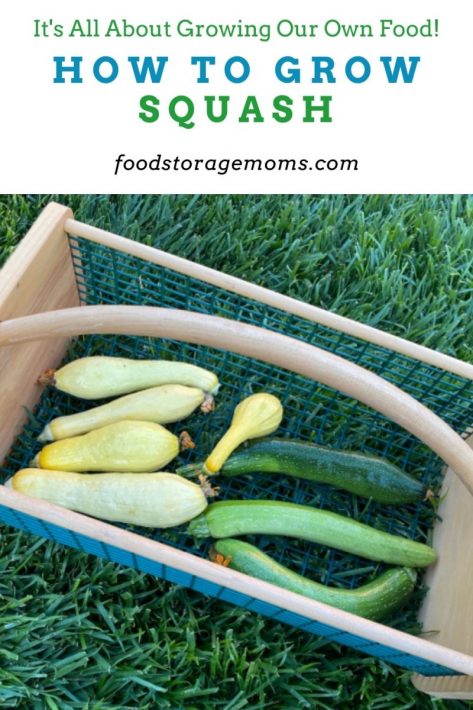
Soil Amendments
Before we get started with planting seeds, let’s be sure your soil is ready. Here are my tips for soil, I do this every Spring and Fall.
The first thing we need to do is pull and remove any weeds that have come up since the last time you turned over the soil. Dig out any leftover crops that you may have missed the last time you harvested. Turn the soil several times and add the following amendments, if you need them.
Soil pH Levels
What Does The Term pH Level Mean?
Are you wondering what the term pH level is when gardening? Each plant prefers a different level of acidity to grow the very best harvest. The level of acidity desired varies between each plant variety. Therefore, you can adjust the pH of your soil by adding lime or sulfur to bring it up or down depending on what your unique soil needs. You can have your soil tested, possibly by your state extension service, at a local nursery that provides that service, or try and do it yourself with a soil tester. pH Tester
How To Hand Pollinate
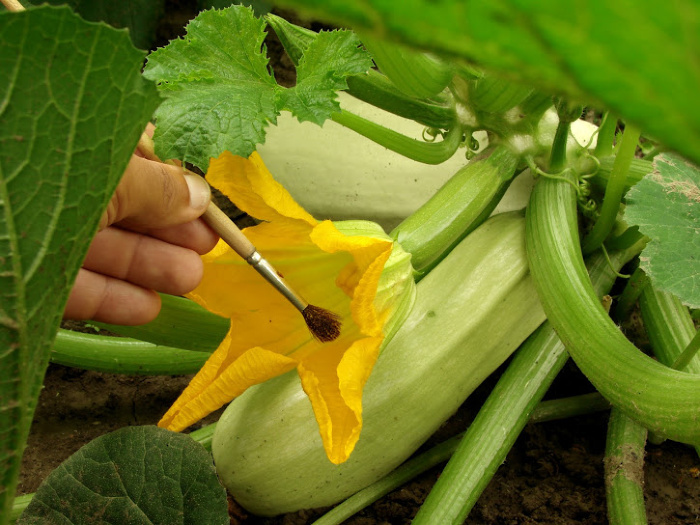
All you need is a paintbrush if you want pollination of your own squash. If you need to hand pollinate because you are not seeing any fruit develop here is something you may want to try. You do this by removing the male flowers blossom (male blossoms don’t have fruit behind them).
They produce pollen leaving the center covered in the pollen to collect with the brush. Use a “brush” to apply the pollen you collected to the center of the female flower. This works for squash, melons, and cucumbers every time.
I’ve also found that having good flowering companion plants nearby helps with pollination. If you can attract bees to the flowers your pollination problems may be solved.
Zucchini Squash
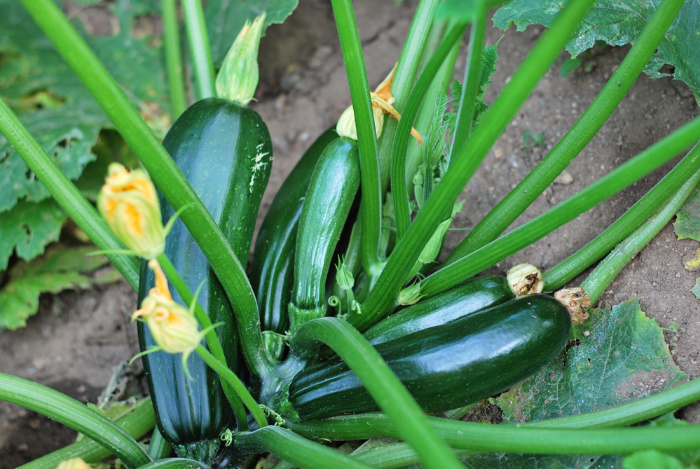
Yellow Straight Neck Squash
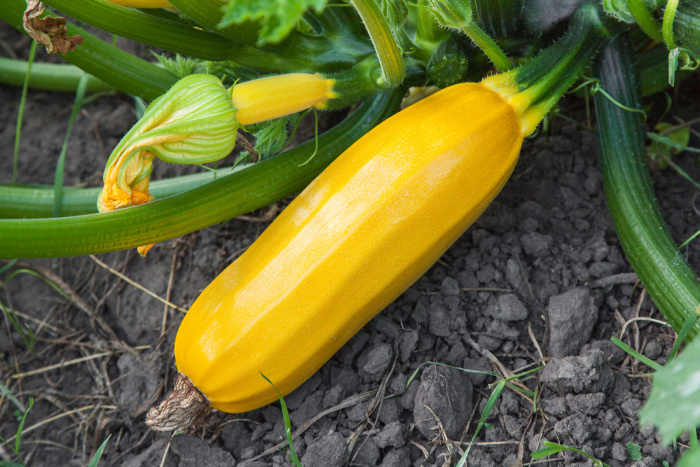
Crookneck Squash
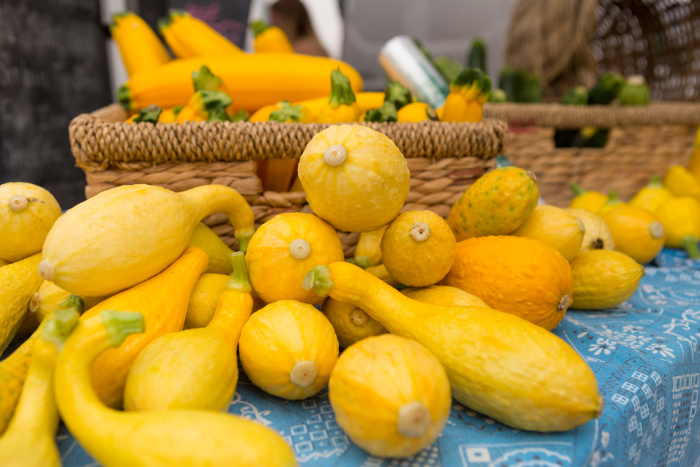
Plant Squash Seeds
Summer Squash Varieties: zucchini, crookneck, and straight-neck (harvested in the summer before they reach maturity).
Winter Squash Varieties: pumpkins, butternut, acorn, and spaghetti squash (harvested in the autumn months after they reach maturity).
When you plant the seeds, test the soil to make sure it is at least 60 degrees F. before sowing your seeds. You for sure want to dodge the last frost date for successful growth. They need full sun exposure. They need loamy soil rich in nutrients. The soil must drain properly. Plant the seeds in hills (2-3 seeds each) one-inch deep. Space them 2-3 feet apart.
Thin as needed to produce the strongest plant. Use a cloche to keep the plants warm in case of cool weather. Mulch the plants to keep them moist and weed-free. When the first blooms appear, fertilize the plants. Nitrogen is a great addition for squash plant growth.
Water deeply at least one inch of water per week. The soil needs to be moist 4 inches down. If your blossom ends turn black and rot, then you have blossom rot. It’s usually caused by uneven moisture in the soil. It could be a calcium problem too.
Water must be consistent and frequent for the fruit to produce. If the fruits are misshapen they may not have received enough water or fertilizer. Check for fruit you can pick daily, they grow faster than you may think.
pH level for Squash: 5.5-6.8
Squash Problems
Squash Bugs
You may have seen these small, tiny, flat, brownish-gray bugs underneath the leaves and near the crown of the plant. These insects lay copper-brown colored eggs. These pests are about 1/2 inch in size. Keep an eye out for a full-blown infestation.
We have to keep on top of this pesky bug. The eggs hatch every ten days, you can scrape the eggs off with a butter knife. Dispose of them in a bag tied tightly in the garbage. You can use row covers to try and keep from getting them. You roll out the cloth and place rocks or bricks to keep the cloth in place.
Also, keep your eyes out for the squash vine borer pests on the stems of your squash vines. Cucumber beetles can also be a problem in some locations.
Powdery Mildew
It makes the leaves look like they are dusted lightly with flour. You will see blotchy white patches spread out on the leaves. It mainly shows up on the upper leaves but may show up underneath the leaves as well. I have used white vinegar mixed with water to spray the fungus. I use 2-3 teaspoons of vinegar (5% acidic) to one gallon of water in a spray bottle. Spray often.
Sometimes mildew on plants is from poor air circulation. Make sure your plants have room to grow and not get smothered.
Poor Soil
Summer squash needs good soil, if you use good organic compost and mulch you should be fine. Some gardeners like to add clean manure. I use 2 cups of 16-16-8 fertilizer per 50 square feet of garden.
Blossom End Rot/Vine Borer
Inconsistent watering may cause blossom end rot. If they don’t get enough water then a calcium deficiency may occur. If the plants suddenly die, it may be the vine borer mentioned above attacking your squash vines. Keep an eye on the main center section of the plants. The vine borer eats through the stock and you will see sawdust-like crumbs. They fly during the day and are black and red with dark wings.
Lack Of Water
Here you walk a fine line, don’t water too much, but water enough so the plants thrive. They need about an inch of water each week. If you dig down in the soil about 3-4 inches check the soil, if it’s dry, it’s time to water the plants.
If you haven’t tried drip irrigation in your garden you need to give it a try. We used it successfully when we lived in the St. George, UT area. We found it also saved on our overall water usage.
Not Enough Sunshine
Squash needs a minimum of six to eight hours of full sun each day. If the plants are lanky and stringy they are lacking the sun they need. If the leaves are a very pale green color that is another indication of needing more sunshine each day.
How To Grow Squash
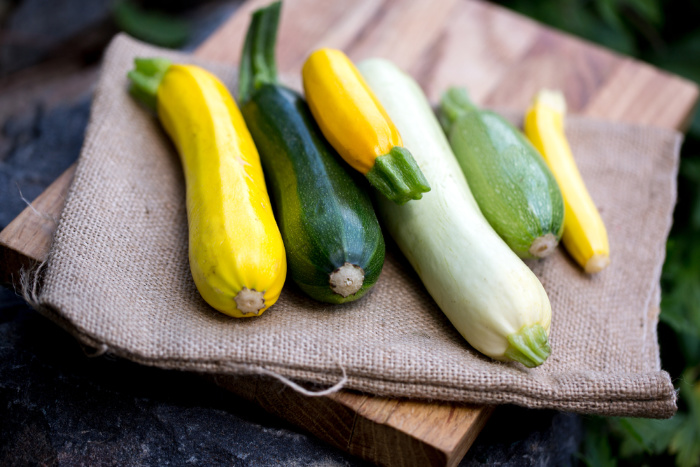
Final Word
I hope today I get you excited about growing a garden. For the last three years, I have had trouble growing squash, as in zucchini. I thought to myself, no one on earth has trouble growing zucchini. Well, I did. But not anymore once I learned why my plants were not producing. They needed my help by pollinating them by hand. Yes, it’s easy and you can do it too! All you need is a good paintbrush. It’s all about being self-reliant. May God bless this world, Linda

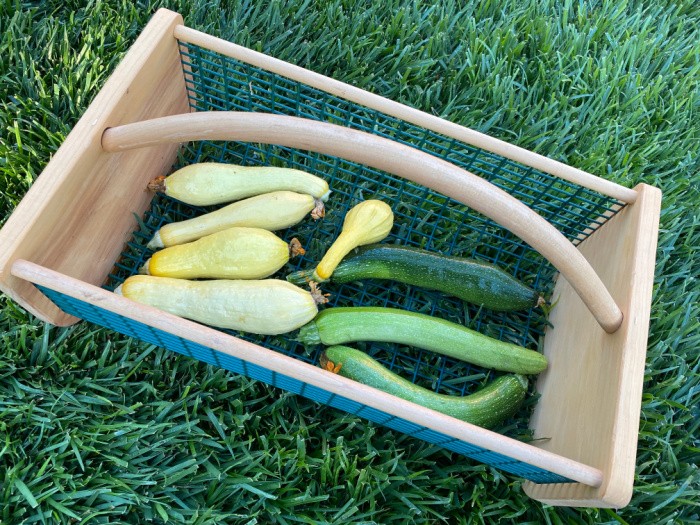

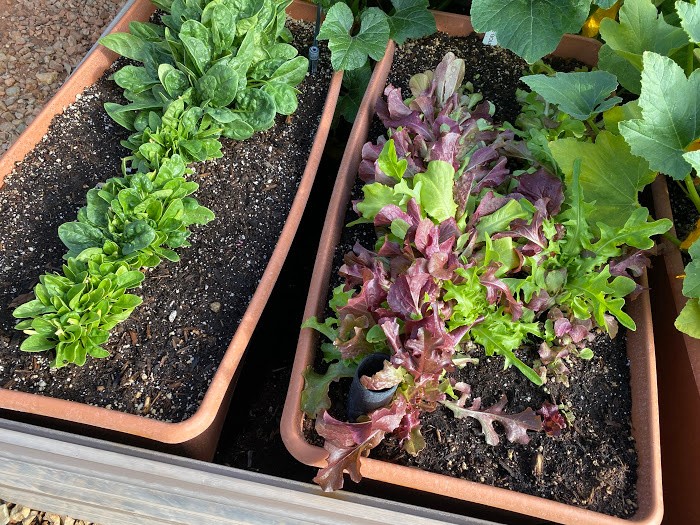
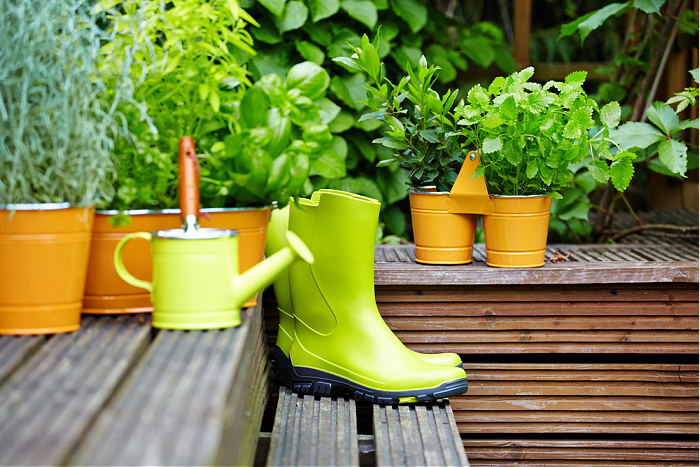
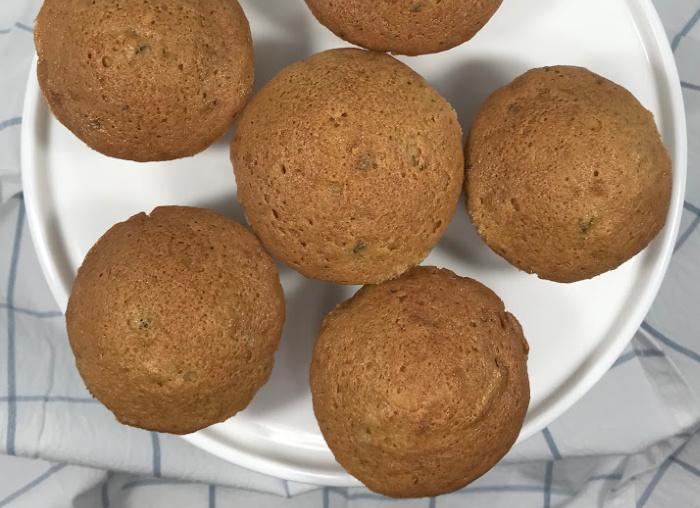

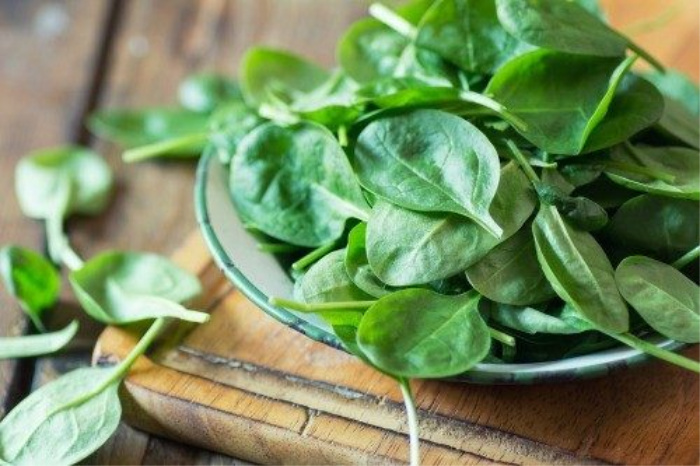
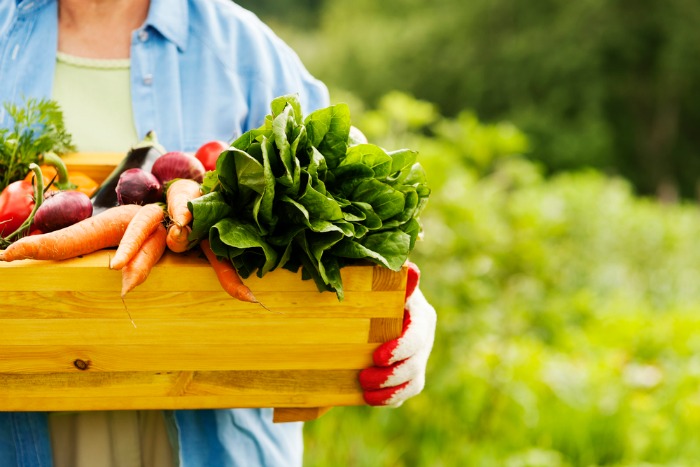
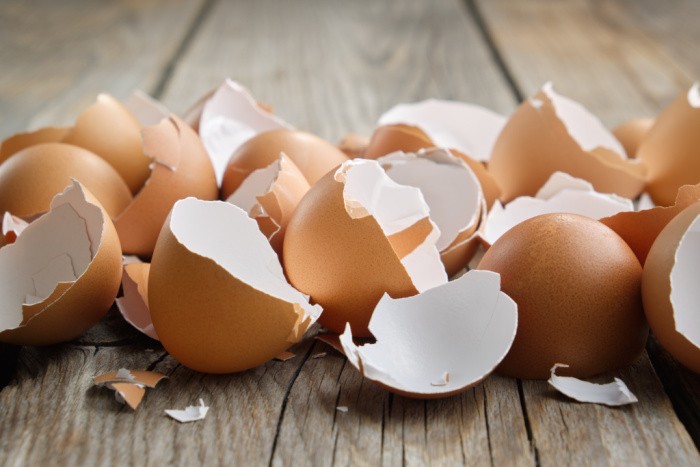

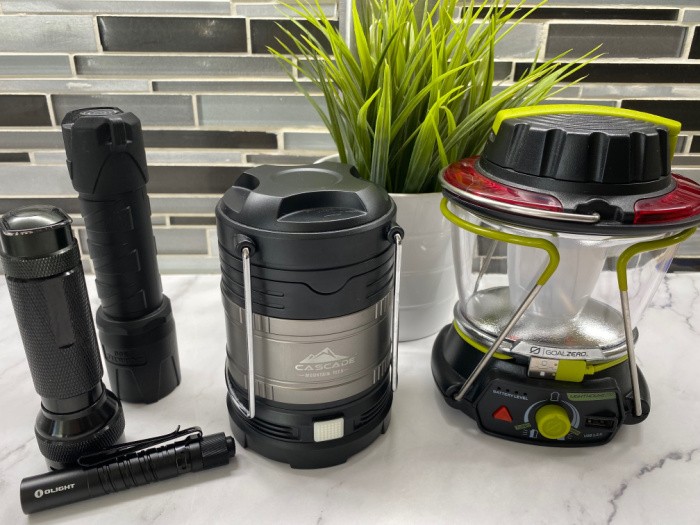
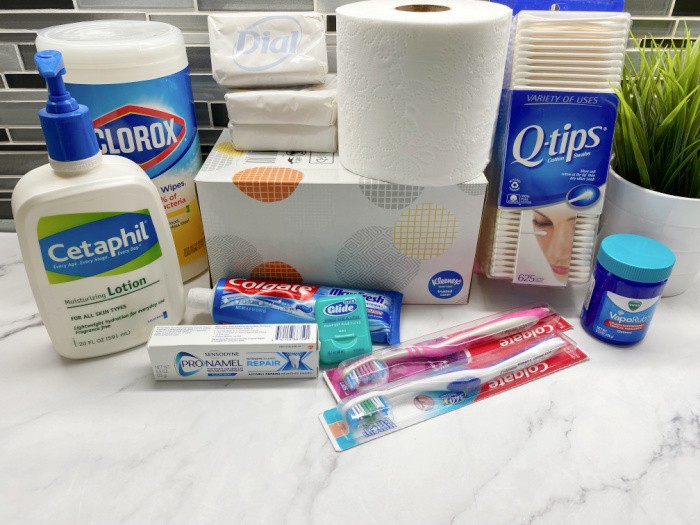
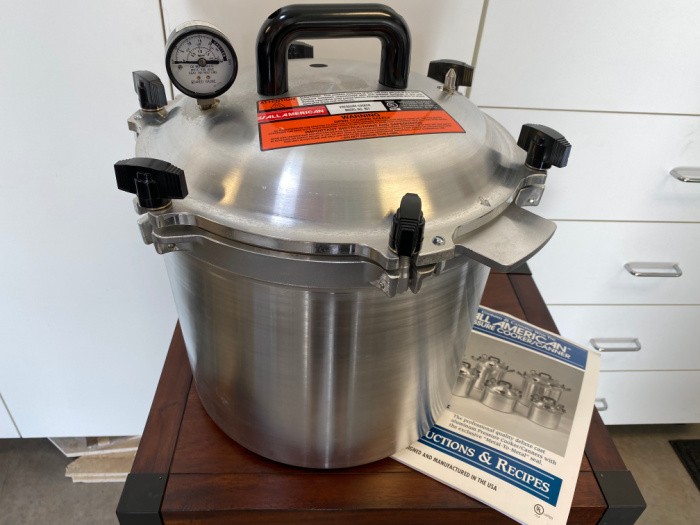
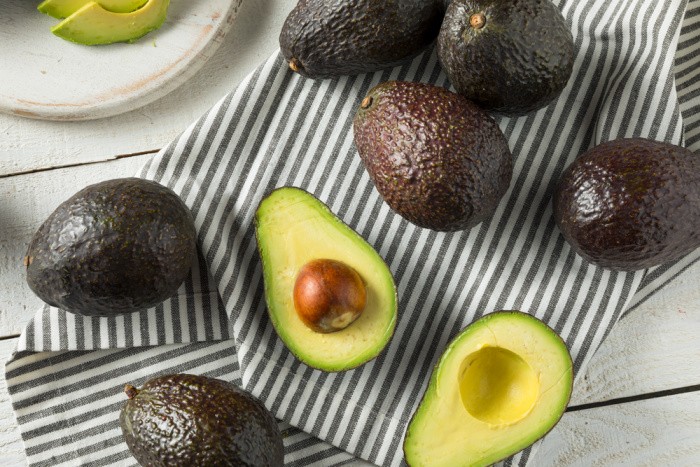

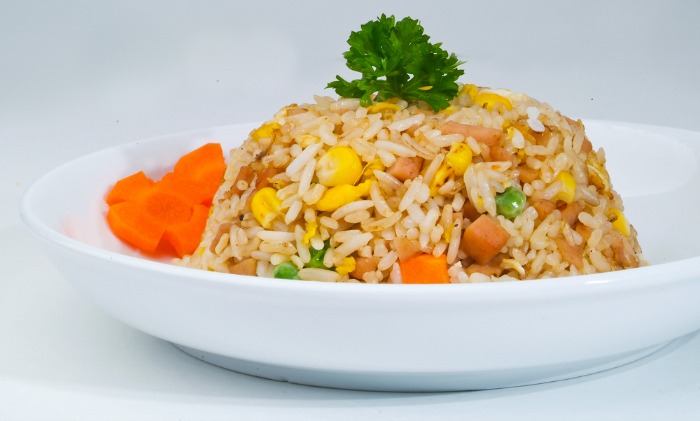
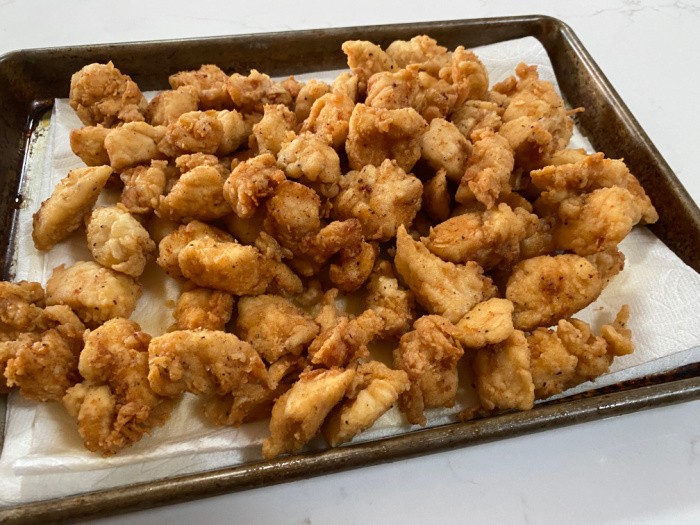





Linda, check out zephyr squash. It is our new summer squash fav! A cross between yellow and zucchini, it is firmer and more flavorful. Perfect for grilling as it retains the firmness, which includes your leftovers quickly microwaved.
Hi Marilynne, oh, I love hearing about Zephyr squash!! Oh my gosh, I love any kind of squash!! I’m going to order some of these seeds! Thank you, Linda
HELLO, Linda et al.: I agree with Marilynne R. above. Zephyr has been my absolute FAVORITE summer squash for several years now. I never plant squash without adding in a patch of zephyr! They are beautiful to look at (1/2 bright, shining yellow and the bottom half or less is a spritely green, as well as they are very “mellow” tasting. We love zephyr squash as much as sweetcorn, when you steam it, melt butter on it and sprinkle salt over it…no grilling needed over here! I am actually going to go lightly steam some in a few mins. and then freeze dry our extra zephyr squash. A happy surprise this summer: We discovered that even the medium-large zephyrs remain very tender and are still just fantastic for steaming! Yay! No more harvesting all the small ones for dinner without letting them grow to size. We easily can use them all!!! We also tried a “new-to-us” variety of butternut squash, recommended by Fedco Seeds, where all of our local organic growers purchase their seeds. They were described as a “the vines will take over your garden” variety but very prolific producer! Well, they weren’t kidding. I will need to find out the variety name again and share with you all in a later post. So far, we intentionally planted only 3 holes of these “proflic” butternut squashes and planted them almost next to the fence so they could crawl up it. Instead, they have grown right through our old chain-link fence plus have taken over about 10-12 feet of the black plastic section we left for them to spread! HOLY SMOKES! They must like the crazy weather we’ve had this summer, cause there are TONS of medium-sized butternuts out there!! (With Zinnias in between the plants, wherever they could find some sun in between all of those squash leaves!! We buy almost all of our seeds from Fedco Seeds, due to their great availability of organic seeds and they do well in our climate.
Also, I never knew that “straight neck” squash were actually yellow zucchini squash (as in your photo). Is there a difference between those yellow zukes and green zukes? (If spellcheck screws up my typing again and keeps replacing zukes with nukes, please forgive!)
I can never use all of the zucchini we end up getting, anyway, so give a lot of them away to people who like zucchini bread a lot. They just grind them up and make zuke bread all winter. We have to do G/F and I am allergic to cinnamon, so we don’t bother with that. Our favorite thing is to wait until they are “clubs”, cut them down the center, scoop out the seeds and fill with herbed meatloaf. Then I cover the top with some sort of tomato paste/ketchup and various herbs mixture and bake for 1 hr. FANTASTIC and my guys actually look forward to eating this meal each summer!
IF ANYONE could share their favorite zucchini recipe(s) on this website, or if Linda could dedicate one posting to zuke recipes, that would be very MUCH APPRECIATED!! I have not found much for decent zucchini recipes, so I end up giving a lot of the bounty away (after I’ve made my zucchini pickles, that is).
About Squash Vine Borers: These are the terror of every squash patch! They can decimate your squash plants in a matter of hours and there goes your harvest. I have seen many recommendations for using a pen knife to dig the larva out of the stems of the plants, but have never done that. Gross!!! OUR SOLUTION? We plant beautiful zinnias and large firecracker marigolds all around the squash patch, and the squash vine borers and virus-carrying squash bugs seem to just stay away. This is my 3rd year planting zinnias between and around squash plantings. So far, we have not had the same problems we used to with squash vine borers, PRAISE THE LORD! PLUS, you end up with some of the most beautiful colors just beaming between all the dark green leaves. SO BEAUTIFUL!! I love to use the Cut and Come Again Zinnias, for their beautiful colors and hardiness, but now am on to the Amethyst & Chartreuse & Salmon-colored varieties and the giant ones, too! Gee all this “talk” makes me want to go out to see what’s what in the garden today! Probably more waves of blackberries and the tail end of our blueberries* (thank God* they’re almost finished)! I’ve been scrambling like a maniac, trying to figure out what to do with all of the blackberries, and who to give berries to, just to get rid of them. Blackberries don’t freeze-dry very well, or that would be the obvious solution… PLUS, the aronia berries still have another 25 quarts left on the bushes and we don’t know what to do with all of those yet, either!! I think they would be too astringent to bother to freeze-dry those, even though they are one of the top superfoods on the planet. But where to put them all??? HELP!!!!!!!!!! Sure wish some of you all food storage people lived closer!
Best to all,
HI Joyce, I wish I lived closer I would come and help pick some blackberries to preserve! Wow, what a blessing to have beautiful flowers and harvest zucchini/squash all summer! I can almost see the beauty of the colors you are describing!! LOVE this!!! Linda
P.S. I will look for my zucchini recipes. The bad thing is, it’s almost 2 years since we moved here and my cookbooks are in the storage unit. June K. shared her zucchini cake and it is to die for. https://www.foodstoragemoms.com/zucchini-cake-recipe/. My new website is going to be easier to find recipe once I get through linking them all. I will work on the zucchini recipes today. Linda
Linda: Looks wonderful, but I am allergic to Cinnamon (as mentioned in my loooong post), so I cannot make this cake. Tks. for trying, though! I wonder if Cardamom would work O.K.?
Joyce S. (JESS)
LINDA! We are hoping our garden actually works out this fall in Florida. I love all of these recommendations.
Hi Jess, it’s so fun to grow our own food!! Keep me posted how your garden does! Linda
Linda,
I normally grow Black Beauty Zucchini every year, but this year I passed as I was focused on melons.
I have to try Zephyr now, even though it’s a hybrid.
The best winter squash I’ve ever grown is Hopi Pale Gray. Even if you let it get huge it’s still delicious and once picked it lasts for several months. I’ve had it last all the way until my zucchini came in the following year.
And for Jess, here’s my favorite Blueberry Zucchini Bread recipe:
Blueberry Zucchini Bread
cooking stats
Prep 15 m
Cook 50 m
Ready In 1 h 45 m
“Blueberries and zucchini baked up into delicious little summertime bread loaves!”
Ingredients
3 eggs, lightly beaten
1 cup vegetable oil
3 teaspoons vanilla extract
2 1/4 cups white sugar
2 cups shredded zucchini (wrung out to remove excess moisture)
3 cups all-purpose flour
1 teaspoon salt
1 teaspoon baking powder
1/4 teaspoon baking soda
1 tablespoon ground cinnamon
1 pint fresh blueberries
Directions
Preheat oven to 350 degrees F (175 degrees C). Lightly grease 4 mini-loaf pans.
In a large bowl, beat together the eggs, oil, vanilla, and sugar. Fold in the zucchini. Beat in the flour, salt, baking powder, baking soda, and cinnamon. Gently fold in the blueberries. Transfer to the prepared (greased) mini-loaf pans.
Bake 50 minutes in the preheated oven, or until a knife inserted in the center of a loaf comes out clean. Cool 20 minutes in pans, then turn out onto wire racks to cool completely.
OR Bake in All American Sun Oven until a toothpick inserted in the middle comes out clean–that’s when it’s done, (takes 1 ½ to 2 hours).
Hi Ray, oh my gosh, this recipe looks awesome!! I need to make this one asap! Linda
Thank you, Ray! Don’t I wish! However, my allergy to Cinnamon is not made up. I seriously cannot eat this without going to the hospital or dying! Truly…
Hi Joyce, I know a lot of readers who cannot eat certain foods or even smell a fragrance and they get deathly ill. We all know our limits, take care and stay away from cinnamon! Linda
Jess, just leave the cinnamon out. It still tastes great.
Hi Ray, I bet it still tastes good with or without the cinnamon. This is why we cook from scratch so we can trade out spices! Love this! Linda
Thanks to Linda and all who have offered me zucchini cake or bread recipes. I can only dream of those, though, as if I eat cinnamon or even cassia (a cousin), I almost stop breathing! Cinnamon allergy is quite dangerous and more common than most people think! Unfortunately, I cannot use zucchini baked good recipes due to all the cinnamon and “hard” spices that I am allergic to! IF only…. Thanks for the info., anyway. Maybe someday I will try a different spice to see what almost tastes O.K.
BTW, sorry that my last huge posting was SO LONG and rambling to and fro, but I sure hope someone found out some good info. on making the most of your squash plantings before the insects do! 🙂
Yeah, I am begging my husband to set up the old Squeezo with a berry seed extractor so I can make some sort of jam or jelly out of some of these waves of berries. AND the Azure Bing Cherries are supposed to arrive tomorrow, too! I think our freeze-drier will raise the electric bill this month! 🙂
Hi Joyce, I LOVE long posts they teach all of us something new! Boy, not being able to eat cinnamon, that would be so hard. I’m so sorry to hear that!! Yes, I think all of my recipes would have cinnamon, darn it! Linda
Dear, dear Linda: I have found that other herbs and spices actually taste better in fruit recipes. I use Ginger a lot more and BOY does it ever taste better than Cinnamon!! Other than that, we also use a lot of vanilla, berried flavorings, citrus oils and peels, etc. and don’t really miss the Cinnamon anymore. Sometimes, I’ve gotten away with using Cardamom, though I usually go light on even that, just to be sure. Even Nutmeg gives me trouble, so I really have to be careful with all of those “mixed spices” products and recipes. No more pumpkin pie for me! HOWEVER, I have found that ginger with butternut squash is FANTASTIC and I constantly get queried what was it that I used in my squash, because others also LOVE IT! 🙂 My family always looks for the gingered squash at Thanksgiving time! 🙂 Have a great day! Thankfully, I found a friend from church who is also coming to Azure pickup tomorrow who will take some blackberries off my hands, THANK YOU GOD! I hate sounding so ungrateful, but we seriously do not know what to do with this many!! Maybe next year, if the world is still turning, we could set up a little stand to sell berries???
Hi Joyce, Oh, I would sell you berries for sure! I just went to a Farmers Market on Saturday and they were selling raspberries for $45.00 for a flat. They were too expensive for my taste. I won’t be making freezer jam this year. Food prices are so high, I have to stay out of the grocery stores because I will not cave to those prices. I love butternut squash! I just put butter on it, now my mouth is watering! Linda
Just bake it, scoop it out and put maybe 1 packet of sweet leaf stevia, butter and ginger juice or powder. YUMMY!
Hi Joyce, that sounds so yummy! Linda
Jess (and others with lots of zucchini),
This zucchini relish is fantastic and a wonderful topping on so many dishes!
https://becomingafarmgirl.com/best-all-purpose-zucchini-relish-easy-canning-recipe/
I Sharon, oh this looks awesome, thank you for the link!! Linda
Hello Linda, this is not about squash, but I like the crookneck yellow squash. This is about the article on rice from a couple of weeks ago. I went to Stop n Shop 2 weeks ago and they did not have a 10 pound bag of Uncle Ben’s rice, none! They did have a 5 pound bag that was $9.99 which I brought. I did not want to take a chance that I would not find Uncle Ben’s rice. I went to Food Bazaar several days later and they had a few 10 pound bags; they were $14.99 and the 5 pound bags were $9.99. I see what you mean about rice being scarce; bags used to be piled high, now you’re lucky if you find any. Since I am a 1-person household, a 5 pound bag will last me quite a while. I will probably get another bag of rice in November to make sure I get through the winter. Thank you all for your help. God bless you and everybody that helped. Enjoy the rest of the summer!
HI Mildred, I love crookneck yellow squash too! I slice it, dip in milk and fry it in oil, it’s so good!! Oh, I’m glad you found rice, yay!!!! Groceries are so expensive, I do not know how families are feeding themselves. Yes, we will all enjoy the rest of the summer, thank you, my friend, Linda
I love squash! I have always been a winter squash fan but I finally found a recipe that I really enjoy for using summer squash – I especially like zucchini in the following recipe.
Anyone remember Bisquick Impossible Pies? I have one of the original recipe pamphlets from a magazine (not handy since I am still not settled in my new home – everything is in storage). But basically the Impossible pies use Bisquick to make a crust of sorts. So many pies you can make – from savory to sweet! But the one I am most fond of is a Vegetable Impossible Pie. I have used green beans in it but I favor using summer squash.
Vegetable Impossible Pie (note – you can google Bisquick Impossible Pies – they are now called Impossibly Easy Pies)
Basic recipe:
2 cups thinly sliced or chopped fresh vegetables (zucchini, other summer squash, trimmed green beans-lightly steamed, tomatoes, etc., or combinations of them)
1/3 cup chopped onion
1 cup shredded Cheddar cheese (4 ounces) or other cheese you might have on hand
1/2 cup Original Bisquick™ mix
1 cup milk
1/2 teaspoon salt 1/4
teaspoon pepper
2 eggs
Preheat oven to 400F. Grease a 9-inch pie plate. Combine the sliced, chopped or steamed veggies along with the onion and cheese in the pie plate. Using a blender or mixer, blend the Bisquick, eggs, milk and salt/pepper. Pour over the veggie mixture.
Bake for 35-45 minutes or until golden brown and a knife inserted in the center comes out clean.
Another note: I always always add garlic to my veggie pie!! Also, I believe there is a gluten free Bisquick on the market for someone who has that need. Of course, you can always make your own biscuit mix.
Hi Leanne, I totally understand the storage unit, my stuff is still in storage almost 2 years now! Thanks for this recipe, I have Bisquick in the frig. I love this, thank you, Linda
Have to admit I’m not a real squash fan–but I do like young summer squash cut in sticks as a raw veggie with dip, also spaghetti squash (shhh, don’t tell my husband, he still thinks it’s real spaghetti!)
And–my favorite way to plant squash (or pumpkins) is on the manure pile! Compost pile will work as well. Plant the seeds (or seedling plants) into the older pile, not the one currently being filled/built. I’m going to have plenty of spaghetti squash (and toasted seeds) this year, and all I’ had to do was the planting! Haven’t looked at the far side of the pile lately to see how the pumpkins have come along, but hoping for some pickled pumkin as well as some for the chickens to enjoy.
HI Rhonda, oh my gosh, I love spaghetti squash! Oh, don’t you love seeing those pumpkin leaves with the pumpkins hiding under them? Linda
I love all the information in the comments about squash. LOL
Hi Jess, I know, right? I love squash! Linda